Which of the following membrane lipids does not contain a fatty acid tail?
(a)Phosphatidylcholine
(b)A glycolipid
(c)Phosphatidylserine
(d)Cholesterol
(d)Cholesterol
Formation of a lipid bilayer seems to be energetically unfavorable. However, it is actually favored because it allows A higher level of entropy than any other alternative. What makes bilayer formation energetically favorable?
(a)Polar head groups form a hydrogen bonding network at the interface with water.
(b)Water molecules form cage-like structures around hydrophobic molecules.
(c)Hydrogen bonds form between neighboring polar head groups in the bilayer.
(d)Fatty acid tails are highly saturated and flexible.
(b)Water molecules form cage-like structures around hydrophobic molecules.
3.A bacterium is suddenly expelled from a warm human intestine into the cold world outside. Which of the following adjustments might the bacterium make to maintain the same level of membrane fluidity?
(a)Produce lipids with hydrocarbon tails that are longer and have fewer double bonds.
(b)Produce lipids with hydrocarbon tails that are shorter and have more double bonds.
(c)Decrease the amount of cholesterol in the membrane.
(d)Decrease amount of glycolipids in the membrane.
(b)Produce lipids with hydrocarbon tails that are shorter and have more double bonds.
Where does most new membrane synthesis take place in a eucaryotic cell?
(a)Golgi
(b) endoplasmic reticulum
(c)plasma membrane
(d) mitochondria
(b) endoplasmic reticulum
Membrane lipids have different types of movement. Which doesn’t occur spontaneously In Biological membranes?
(a)switching between lipid layers
(b)lateral movement
(c)rotation
(d)flexing of hydrocarbon chains
(a)switching between lipid layers
There are two properties of phospholipids that affect how tightly they pack together: length of hydrocarbon chain and # of double bonds. The degree of packing, in turn, influences the relative mobility of molecules in membrane.
Which would yield the most highly mobile phospholipid?
(a)24 carbons with 1 double bond
(b)15 carbons with 2 double
bonds
(c)20 carbons with 2 double bonds
(d)16 carbons with
no double bonds
(b)15 carbons with 2 double bonds
7.Cholesterol serves several functions in mammalian cells. Which is not influenced by cholesterol?
(a)membrane permeability
(b)membrane fluidity
(c)membrane rigidity
(d)membrane thickness
(d)membrane thickness
New membrane phospholipids are synthesized by enzymes bound to the ______ side of the________membrane.
(a)cytosolic, mitochondrial
(b)luminal, Golgi
(c)cytosolic, ER
(d)extracellular, plasma
(c)cytosolic, ER
Membrane synthesis in the cell requires the regulation of growth for both halves of the bilayer and the selective retention of certain types of lipids on one side or the other. Which enzymes accomplishes both tasks?
(a)flippases (b)phospholipases (c)convertases (d)glycosylases
(a)flippases
Unlike soluble, cytosolic proteins, membrane proteins are more difficult to purify. Which of the following substances is most commonly used to help purify a membrane protein?
(a)high salt solution (b)sucrose (c)detergent (d)ethanol
(c)detergent
We know the detailed molecular structure and mechanism of action of the transmembrane protein bacteriorhodopsin. This protein uses sunlight as the source of energy to pump ______ out of the cell.
(a)4 ATP (b)7 H+ (c)7 K+ (d)4 Na+
(b)7 H+
Plasma membranes are extremely thin and fragile, requiring an extensive support network of fibrous proteins. This
network is called the ______.
(a)cortex
(b)attachment complex
(c)cytoskeleton
(d)spectrin
cortex
Red blood cells have been very useful in the study of membranes and the protein components that provide
Structural support. Which of the following proteins is the principal fibrous protein in the cortex of the red blood cell?
(a)tubulin
(b)attachment proteins (c)actin (d)spectrin
spectrin
Diversity in the oligosaccharide chains found in the carbohydrate coating of the cell surface can be achieved in?
(a)varying the types of sugar monomers used (b)varying the types of linkages between sugars
(c)varying the number of branches in the chain (d)all of the above
all of the above
The endothelial cells found closest to the site of an infection express proteins called lectins. Each lectin binds to a
particular ______ that is presented on the surface of a target cell
(a)oligosaccharide (b)aminophospholipid (c)polysaccharide (d)sphingolipid
oligosaccharide
Which of the following statements is true?
(a)Phospholipids will spontaneously form liposomes in nonpolar solvents.
(b)In eucaryotes, all membrane-enclosed organelles are surrounded by one lipid bilayer.
(c)Membrane lipids diffuse within the plane of the membrane.
(d)Membrane lipids frequently flip-flop between one monolayer and the other.
Membrane lipids diffuse within the plane of the membrane.
Porin proteins form large, barrel-like channels in membrane. Which is not true about these channels?
(a)They are made primarily of α helices. (b)They are made primarily
of β sheets.
(c)They cannot form narrow channels.
(d) have
alternating hydrophobic and hydrophilic amino acids.
(a)They are made primarily of α helices.
Both glycoproteins and proteoglycans contribute to carbohydrate layer on cell’s surface. Which is not true?
(a) can be secreted into the extracellular environment.
(b)
They have only one transmembrane domain.
(c) They have long
carbohydrate chains.
(d) They are recognized by lectins
(c) They have long carbohydrate chains.
Which of the following statements about the carbohydrate coating of the cell surface is false?
(a) It is not usually found on the cytosolic side of the membrane.
(b) It can play a role in cell–cell adhesion.
(c)arrangement of the oligosaccharide side chains is highly ordered, much like the peptide bonds of a polypeptide chain.
(d) Specific oligosaccharides can be involved in cell–cell recognition.
(c)arrangement of the oligosaccharide side chains is highly ordered, much like the peptide bonds of a polypeptide chain.
Although cholesterol is hydrophobic, it has a hydrophilic head group like all other membrane lipids.
True
Phosphatidylserine is the most abundant phospholipid found in cell membranes.
False
Glycolipids lack the glycerol component found in phospholipids.
True
The highly ordered structure of the lipid bilayer makes its generation & maintenance energetically favorable.
False
Lipid-linked proteins are classified as peripheral membrane proteins because the polypeptide chain does not pass through the bilayer.
False
A protein can be embedded on the cytosolic side of the membrane bilayer by employing a hydrophobic α helix.
False
A protein that relies on protein–protein interactions to stabilize its membrane association is classified as a peripheral membrane protein because it can be dissociated without the use of detergents.
True
Membrane proteins that pump ions in and out of the cell are classified as transporters.
False
When a mouse cell is fused with a human cell, the movement of the respective membrane proteins is restricted to their original locations at the time of fusion.
False
Epithelial cell membranes are asymmetric, and proteins from the apical side of the cell membrane cannot diffuse into the basal side of the membrane.
True
The longest carbohydrates found on the surfaces of cells are linked to integral membrane proteins.
True
The only role of the carbohydrate layer on the cell surface is to absorb water, which creates a slimy surface and helps the cell-cell recognition.
False
The specialized functions of different membranes are largely determined by the _1_ they contain. Membrane lipids are _2_ molecules, composed of a hydrophilic portion and a hydrophobic portion. All cell membranes have the same _3__ structure, with the _4_ of the phospholipids facing into the interior of the membrane and the _5_ on the outside. The most common lipids in most cell membranes are the _6_. The head group of a glycolipid is composed of _7_.
a.Amphipathic; b.hydrophobic; c.phosphatidylserine; d.cholesterol; e.lipid bilayer; f.phospholipids; g.fatty acid tails; h.lipid monolayer; i.proteins; j.glycolipids; k.lipids; l.sterols;
m.hydrophilic head groups; n. phosphatidylcholine; o.sugars
1. proteins
2. amphipathic
3. lipid monolayer
4. fatty acid tails
5. hydrophilic head groups
6. phospholipids
7. sugars
There are several ways that membrane proteins can associate with the cell membrane. Membrane proteins that extend through the lipid bilayer are _1_ proteins and have _2_ regions that are exposed to the interior of the bilayer. On the other hand, membrane-associated proteins do not span the bilayer and instead associate with the membrane through an α-helix that is _3_. Other proteins are _4_ attached to lipid molecules inserted in the membrane. _5_ membrane proteins are linked to the membrane through noncovalent interactions with other membrane-bound proteins.
a.Amphipathic b.hydrophilic c.noncovalently d.Cortical e. hydrophobic f.peripheral
g.Covalently h. integral i.transmembrane j.Detergent k.micelle l.unfolded
1. transmembrane
2. hydrophobic
3. amphipathic
4. covalently
5. peripheral
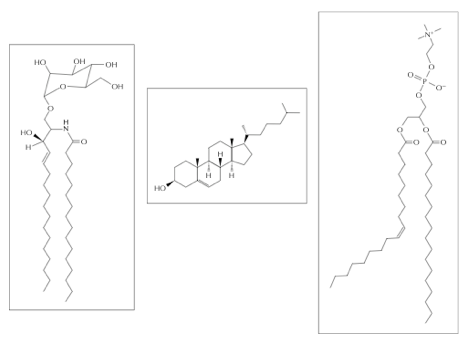
Identify the 3 membrane components shown and label
the chemical groups.
A.glycerol B.sugar
C.phospholipid D.glycolipid
E.sterol F.unsaturated hydrocarbon
G.saturated hydrocarbon H.sterol polar head group
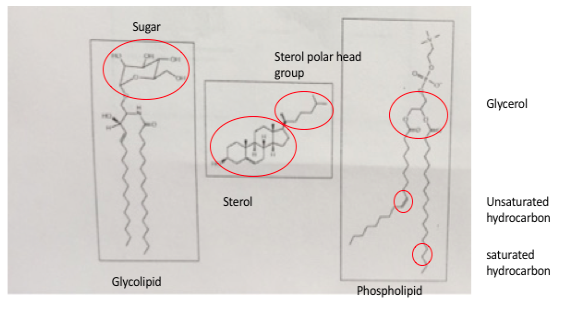
Although the extracellular environment has a high sodium ion concentration and the intracellular
environment has A high potassium ion concentration, both must be neutralized by negatively charged
molecules. In the extracellular case, what is the principal anion?
(a)HCO3 – (b)Cl– (c)PO4 3– (d)OH–
(b)Cl–
Hungry yeast cell lands in a vat of grape juice and begins to feast on the sugars there, producing
carbon dioxide and ethanol in the process: C6H12O6 + 2ADP + 2Pi + H+ 2CO2 + 2CH3CH2OH + 2ATP
+2H2O. Unfortunately, the grape juice is contaminated with proteases that attack some of the
transport proteins in the yeast cell mbr, and the yeast cell dies. Which of the following could account
for the yeast cell’s demise?
(a)toxic buildup of carbon dioxide inside the cell (b)toxic buildup of ethanol inside the cell
(c)diffusion of ATP out of the cell (d)inability to import sugar into the cell
(d)inability to import sugar into the cell
Ion channels are classified as membrane transport proteins. Channels discriminate by size and
charge. In addition to Na+, which ions would you expect to freely diffuse through a Na+ channel?
(a)Mg2+ (b)H+ (c)K+ (d)Cl–
(b)H+
H+ because it is positively charged and small enough to fit through the channel
Transporters, in contrast to channels, work by ________________.
(a)specific binding to solutes
(b)a gating mechanism
(c)filtering solutes by charge (d)filtering solutes by size
(a)specific binding to solutes
Pumps are transporters that are able to harness energy provided by other components in the cells
to drive the movement of solutes across membranes, against their concentration gradient. This type
of transport is called _.
(a)active transport (b)free diffusion (c)facilitated diffusion (d)passive transport
(a)active transport
In cells H+ electrochemical gradients: which H+ transporters regulates pH in animal cells?
(a)light-driven pump (b)H+ ATPase (c)H+ symporter (d)Na+-H+ exchanger
(d)Na+-H+ exchanger
Ca2+ pumps in the plasma membrane and endoplasmic reticulum are important for _____________.
(a)maintaining osmotic balance (b)preventing Ca2+ from altering activity of molecules in cytosol
(c)providing enzymes in the endoplasmic reticulum with Ca2+ ions that are necessary for their catalytic activity (d)maintaining a negative membrane potential
(c)providing enzymes in the endoplasmic reticulum with Ca2+ ions that are necessary for their catalytic activity
Which of the following best describes the behavior of a gated channel?
(a)It stays open continuously when stimulated.
(b)opens more frequently in response to a given stimulus.
(c)opens more widely as stimulus becomes stronger (d)It remains closed if unstimulated.
(b)opens more frequently in response to a given stimulus.
Voltage-gated channels contain charged protein domains, which are sensitive to changes in
mbr potential. By responding to a threshold in the membrane potential, these voltage sensors
trigger the opening of the channels. Which best describes the behavior of a population of
channels exposed to such a threshold?
(a)Some channels stay closed + some open completely.
(b)All channels open completely.
(c)All channels open partly, to the same degree.
(d)All channels open partly, each to a different degree.
(a)Some channels stay closed + some open completely.
K+ leak channels are found in the plasma membrane. These channels open and close in an
unregulated, random fashion. What do they accomplish in a resting cell?
(a)They set the K+ concentration gradient to zero
(b)They set the membrane potential to zero.
(c)They disrupt the resting membrane potential
(d)They keep the electrochemical gradient for K+ at 0.
d)They keep the electrochemical gradient for K+ at 0.
If Na+ channels are opened in a cell at rest, how will the resting membrane potential be affected?
(a)The membrane potential is not affected by Na+.
(b)It becomes more negative.
(c)It becomes more positive.
(d)It is permanently reset.
(c)It becomes more positive.
Which of the following is required for the secretion of neurotransmitters in response to an action
potential?
(a)neurotransmitter receptors (b)Na+-K+ pumps
(c)voltage-gated K+ channels (d)voltage-gated Ca2+ channels
(d)voltage-gated Ca2+ channels
The stimulation of a motor neuron ultimately results in the release of a neurotransmitter at the
synapse between The neuron and a muscle cell. What type of neurotransmitter is used at these
neuromuscular junctions?
(a)acetylcholine (b)glutamate (c)GABA (d)glycine
(a)acetylcholine
CO2 and O2 are water-soluble molecules that diffuse freely across cell membranes.
False.
Lipid-linked proteins are classified as integral membrane proteins because although they are not transmembrane proteins, they are covalently bound to membrane lipids and cannot be dissociated without disrupting the membrane’s integrity.
The differences in permeability between artificial lipid bilayers and cell membranes arise from variations in phospholipid content.
False. An embedded protein employs an amphipathic helix. The hydrophobic side interacts with the fatty acid tails of the membrane lipids and the hydrophilic portion interacts with the aqueous components of the cytosol.
Transporters are similar to channels, except that they are larger, allowing folded proteins as well as smaller organic molecules to pass through them.
True
Cells expend energy in the form of ATP hydrolysis so as to maintain ion concentrations that differ from those found outside the cell.
False. Membrane proteins that pump ions in either direction across the membrane are in the functional class of transporters.
Facilitated diffusion or PASSIVE TRANSPORT can be described as the favorable movement of one solute down its concentration gradient being coupled with the unfavorable movement of a second solute up its concentration gradient.
False. This describes coupled transport, which is one type of active transport. Facilitated diffusion can also be called passive transport, in which a solute always moves down its concentration gradient.
Transporters undergo transitions between different conformations, depending on whether the substrate-binding pocket is empty or occupied.
True
The electrochemical gradient for K+ across the plasma membrane is small. Therefore, any movement of K+ from the inside to the outside of the cell is driven solely by its concentration gradient.
True
The net negative charge on the cytosolic side of the membrane enhances the rate of glucose import into the cell by a uniporter.
False. Glucose is an uncharged molecule, and its import is not directly affected by the voltage difference across the membrane if glucose is being transported alone. If the example given were the Na/glucose symporter, we would have to consider the charge difference across the membrane.
Neurotransmitters are small molecules released into the synaptic cleft after the fusion of synaptic vesicles with the presynaptic membrane.
True
Action potentials are usually mediated by voltage-gated Ca2+ channels.
False. Action potentials are usually mediated by voltage-gated Na+ channels.
Voltage-gated Na+ channels become automatically inactivated shortly after opening, which ensures that the action potential cannot move backward along the axon.
True
Voltage-gated K+ channels also open immediately in response to local depolarization, reducing the magnitude of the action potential.
False. Voltage-gated K+ channels respond more slowly than the voltage gated Na+ channels. Because they do not open until the action potential reaches its peak, they do not affect its magnitude. Instead, they help to restore the local membrane potential quickly while the voltage-gated Na+ channels are in the inactivated conformation.
A molecule moves down its concentration gradient by _1_ transport, but requires _2_transport to move up its concentration gradient. Transporter proteins and ion channels function in membrane transport by providing a _3_pathway through the membrane for specific polar solutes or inorganic ions. _4_ are highly selective in the solutes they transport, binding the solute at a specific site and changing its conformation so as to transport the solute across the membrane. On the other hand, _5_ discriminate between solutes mainly on the basis of size and electrical charge.
a.Active b. transporter proteins c.ion channels d.amino acid e.hydrophilic
f.Noncovalent g. amphipathic h.hydrophobic i.passive
- passive
- active
- hydrophilic
- Transporter Proteins
- Ion channels
For an uncharged molecule, the direction of passive transport across a membrane is determined solely by its _1_ gradient. On the other hand, for a charged molecule, the _2_ must also be considered. The net driving force for a charged molecule across a membrane therefore has two components and is referred to as the _3_ gradient. Active transport allows the movement of solutes against this gradient. The transporter proteins called _4_ transporters use the movement of one solute down its gradient to provide the energy to drive the uphill transport of a second gradient. When this transporter moves both ions in the same direction across the membrane, it is considered a(n) _5_; if the ions move in opposite directions, the transporter is considered a(n) _6_.
a.Antiport b. coupled c.membrane potential d.ATP hydrolysis e. electrochemical f.symport g.Concentration h. light-driven i.uniport
- Concentration
- Membrane Potential
- Electrochemical
- Coupled
- Symport
- Antiport
The action potential is a wave of _1_ that spreads rapidly along the neuronal plasma membrane. This wave is triggered by a local change in the membrane potential to a value that is _2_ negative than the resting membrane potential. The action potential is propagated by the opening of _3_-gated channels. During an action potential, the membrane potential changes from _4_ to _5_. The action potential travels along the neuron’s _6_ to the nerve terminals. Neurons chiefly receive signals at their highly branched _7_.
a.Anions b.depolarization c.negative d.Axon e.hyperpolarization
f.Neutral g.synaptic vesicle h. less i-positive j. cytoskeleton
k.ligand l.pressure m.dendrites n.more o.voltage
1. depolarization
2. less
3. voltage
4. negative
5. pressure
6. axon
7. dendrites
Neurons communicate with each other through specialized sites called _1_. Many neurotransmitter receptors are ligand-gated ion channels that open transiently in the _2__ cell membrane in response to neurotransmitters released by the _3_ cell. Ligand-gated ion channels in nerve cell membranes convert _4_ signals into _5_ ones. Neurotransmitter release is stimulated by the opening of voltage-gated _6_ in the nerve terminal membrane.
a.Ach receptor b.GABA receptor c.presynaptic d.Ca2+ channels e.K+ channel f.synapses
g.chemical h. Na+ channels i.electrical j.postsynaptic
1. synapses
2. postsynaptic
3. presynaptic
4. chemical
5. electrical
6. Ca2+ channels
You have prepared lipid vesicles (spherical lipid bilayers) that
contain Na+-K+ pumps as the sole membrane
protein. All of the Na+-K+ pumps are oriented in
such a way that the portion of the molecule that normally faces the
cytosol is on the inside of the vesicle and the portion of the
molecule that normally faces the extracellular space is on the outside
of the vesicle. Assume that each pump transports one Na+
ion in one direction and one K+ ion in the other direction
during each pumping cycle (see figure for how the Na+
K+ pump normally functions in the plasma membrane).
Predict what would happen in each of the following
conditions:
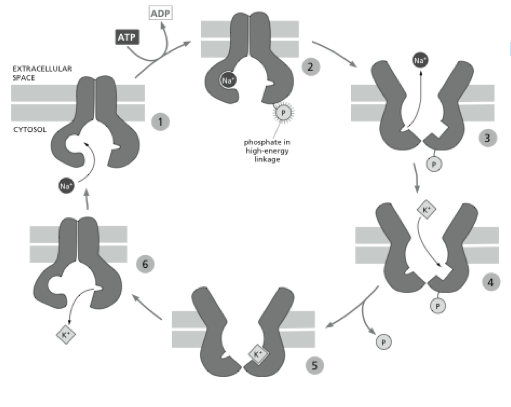

A. The solutions inside and outside the vesicles contain both Na+ and K+ ions but no ATP.
No ATP>> no ions pumped.
B. The solution outside the vesicles contains both Na+ & K+ ions; the solution inside contains Na+ and K+ ions and ATP.
pumps + ATP>> transport Na+ out & K+ into
C. The solution outside contains Na+; the solution inside contains Na+ and ATP.
pump stuck at 3
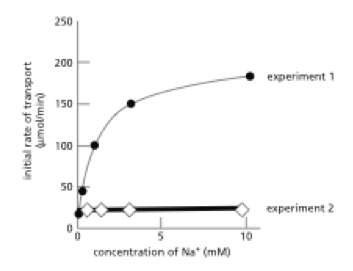
You are testing the rate of glucose transport into vesicles using the Na+ glucose pump.
A.In experiment 1, you employ liposomes that have the pump in the same orientation as that found in the plasma membrane in epithelial cells. These liposomes contain glucose but no Na+ ions. You then transfer the liposomes to a series of tubes with solutions containing the same glucose concentration as that inside the vesicle and 0, 1, 2, 3, or 10 mM Na+. You measure the initial rates of glucose transport and plot your results. Why do the initial rates of glucose transport into the liposome reach a plateau as the concentration of Na+ increases?
transporters require recognition+binding substrate>> reach max
capacity (saturation) 10 mM
In experiment 2, there is one new variable: you have included leaky Na+ channels in the liposomal membrane. Explain the reason for obtaining such different results in experiment 2.
leaky Na+ channels>> equilibration Na+ >> destroying gradient required for glucose transport into liposome
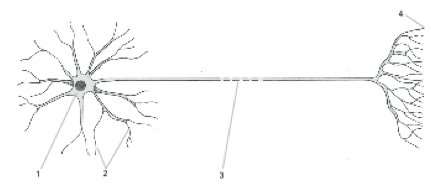
Match the numbered lines with the following structures:
A.nerve terminal
B.cell body
C.axon
D.dendrite
1. Cell Body
2. Dendrite
3. Axon
4. Nerve Terminal